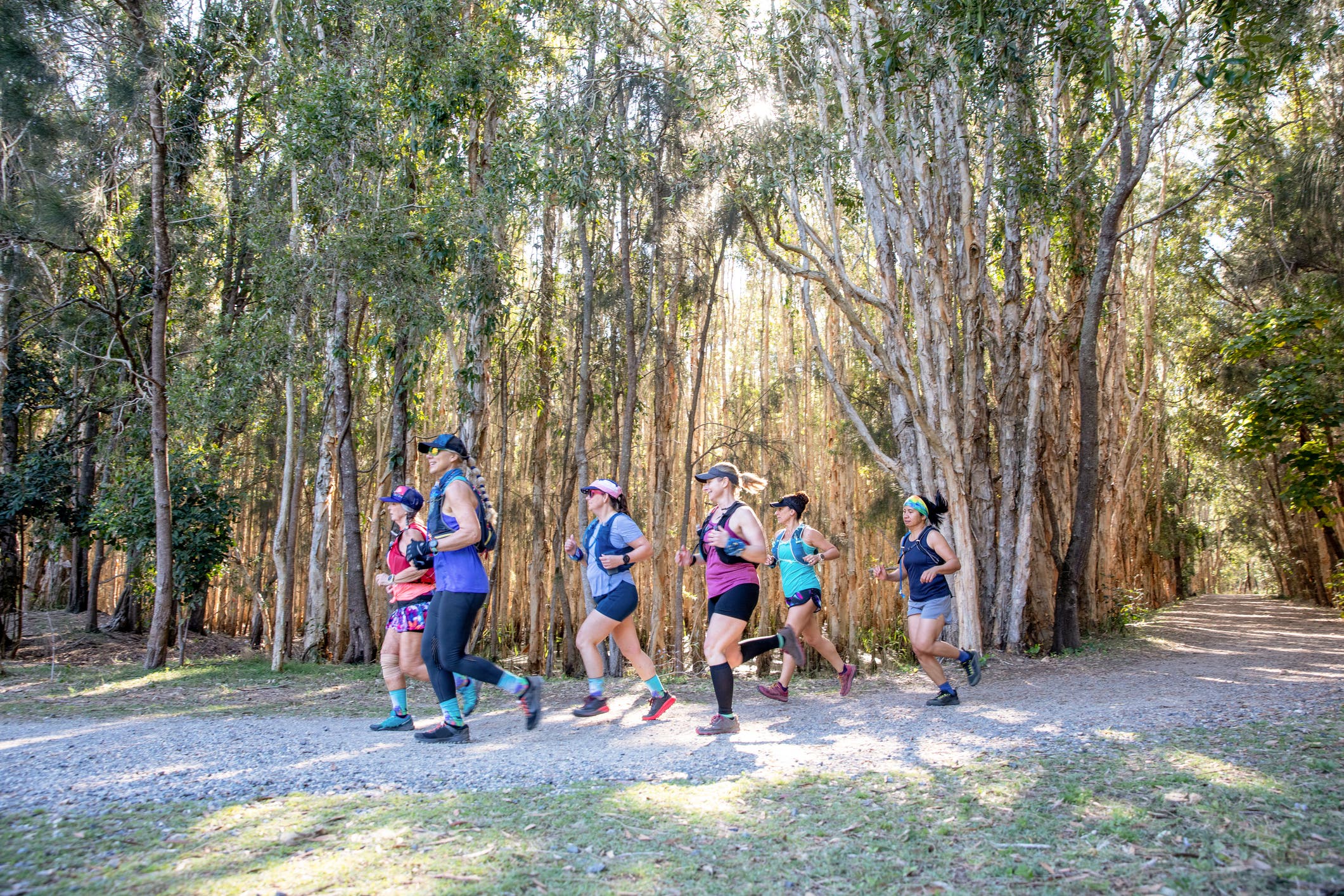10 Ways to Improve Fatigue Resistance For Long Runs

Man and woman running uphill in the mountains
At mile 90 of the 2019 Western States 100, Clare Gallagher was running a legendary race. One of the fastest times ever through the final checkpoints! Still flying! WOW. Almost any other year, it would have been all over except for a victory lap and peeing into a cup while a stranger stood a foot away watching the live-stream.
But not that year. From behind, a headlamp started bobbing toward her. And the headlamp was moving fast. A few minutes later, Clare realized it was friend and international superstar Brittany Peterson, also having a historic day. After nearly 15 hours, the race was officially on.
What happens next?
I’m not talking about what unfolded in the race—we’ve talked about that amazing performance before, when Clare proceeded to set the all-time record for the next section of trail. Instead, I’m asking about what influences performance after 15 hours of pushing. They all want it. They all have world-class physiological profiles. They all are winners at countless other races. So what gives?
Somewhat surprisingly… we are still unsure of the answer to that question.
There are all the normal exercise physiology culprits. Aerobic threshold and running economy can be measured with a mask and a treadmill, muscle damage with a blood test, heart rate with a strap. But what about when all those factors are comparable among competitors, or at least within error bars that are extra-large in ultra events? Why can some athletes train the same, pace the same, fuel the same—yet some have an incredible finish and others experience more lackluster results?
The answer may be found in the emerging study of “fatigue resistance.” Fatigue resistance does not have a set definition but is generally classified as the extent of performance deterioration late in events, often unexplained by normal physiological profiling while fresh. Alex Hutchinson wrote a wonderful primer in Outside, primarily examining one study. That 2021 study in the International Journal of Sports Physiology & Performance examined power profiles of elite cyclists, with the primary difference between under-23 riders and professionals being that the pros could put out higher bursts of power after hours of hard work. Even though their basic power profiles were comparable (the U23 riders actually had higher 5-second power), the deterioration of the power profile toward the end of races explained some performance differences.
That makes intuitive sense when you consider ultrarunning. At the Western States 100 in a couple weeks, there will be a handful of athletes that would likely have similar lactate thresholds, aerobic engines, and overall training approach. Yet they end up finishing many hours apart, even with smart pacing. And it just doesn’t happen at the front of the fields, but all the way to the last finisher and first person to DNF in every ultra. Something that we aren’t always measuring is playing a big role.
Hutchinson literally wrote the book on fatigue (the amazing Endure), and he points out that there is complexity that makes training and understanding this variable difficult. “Fatigue, after all, has many different components: metabolic disturbances in your muscles, altered signals from your brain and through your spinal cord, depleted motivation and cognitive resources.”
If I had to guess, I imagine there’s a high contribution from central fatigue, where the nervous system decreases the neural drive to muscles. A 2012 review in Sports Medicine on central fatigue just adds more complexity to the picture, with the general conclusion that we don’t know for sure why it varies, but it likely matters in endurance performance.
Fatigue resistance (or something impersonating it) is a variable that my co-coach Megan and I noticed was at the forefront of ultra performance right as we started out, to the point that we developed field tests to determine where athletes might fall at baseline and during training blocks. Or maybe the test measures something else entirely—it’s all relatively uncertain still. But whatever is being measured, we have seen the short tests have strong predictive value for 100 milers and beyond. (For those that are curious, the test usually involves a moderate 90+ minute effort followed by a hard finish, recording the ballpark offset between the hard finish performance and baseline lactate threshold performance). Clare is outstanding, as you’d imagine. So are athletes like Drew Holmen and Katie Asmuth, both lining up at Western States in a couple of weeks as well.
RELATED: Use Threshold Training To Run Faster, Longer

Important Overarching Training Point
Running economy is still the most important variable. The fastest athlete with acceptable endurance has a great shot no matter what their fatigue resistance. Eighty percent of a really big number is still better than being able to hold closer to 100% of a much lesser number. But there’s a holy grail I want to help athletes achieve: Let’s hold close to 100% of a really big number.
The problem that I see in ultra training is that some approaches seem almost solely geared to trying to train this amorphous fatigue resistance principle. Yes, it matters. But it’s also highly genetic (probably), and whatever amount it can be trained is still subsumed by actual speed, especially over many training cycles when an athlete can get faster and faster. Get fast as heck, then train your body to hold on tight.
This article provides an overview of some of the ways we have seen what we perceive as “fatigue resistance” improve over time in advanced athletes. Now is the time when I back up a dump truck of disclaimers. First, as mentioned, well-rounded training designed to improve speed and endurance matters most of all. Being really freaking fast provides a lot of margin for error. I have rarely seen the metrics we use for fatigue resistance improve exponentially in developed athletes, but I have seen running economy at aerobic threshold take massive leaps over 3-5 years.
RELATED: Make Faster Running Feel Easier
Second, different things work for every athlete. Fatigue resistance could be connected to muscle fiber typology or similar variables that also implicate different training approaches, so it’s one of many things to consider in a training plan. There are likely so many genetic and environmental factors that we’re playing a bit of pin-the-tail-on-the-donkey with training theory. What I am calling “fatigue resistance” in this article may even be something else entirely, a proxy variable obscuring other training adaptations or genetic predispositions.
Third, the science is unsettled, so everything you’re about to read is based primarily on anecdotes from athletes we have coached, which gives us insight into trends over time. Clare was a fatigue-resistance boss when we met her, so her training might be less instructive. Other athletes have traveled different paths that provide some clues. But as you can imagine, there’s a certain amount of truthiness mixed in with that sort of analysis, where our guts are telling us what patterns are most important. Take what you want, and leave the rest.
Ten tips, trying to give away any special information we might have gathered over time, and all for free! Our business model is just six babies with a toy abacus.
Tip One: Fully fuel and hydrate most training
Glycogen-depletion-induced performance decrease is an element in peripheral rather than central fatigue, but it likely feeds back into how the brain processes efforts over time. Hutchinson interviewed the authors of the cycling study, who said that being low in carbohydrates worsens fatigue resistance, which makes sense. What happens when you are often practicing being low in fatigue resistance? Based on what I have seen, it only gets worse from there.
So practice giving your body and brain the chance to feel and perform better late in runs with full fueling and hydration, including electrolytes. It might make sense to occasionally do long, slow runs or hikes with some depletion, which may provide a training-hack for some of these processes, but almost never for female athletes.
Tip Two: Increase vert in the 6-8 weeks before long events
Emerging theories about delayed-onset muscle soreness indicate that it’s not just what you might think—muscle breakdown from eccentric muscle contractions. It might also involve nervous system changes from the same stress (see this 2020 study). And whenever I see “nervous system” implicated in a breakdown process, my ears perk up, constantly listening for clues.
Vert makes the legs more resilient, and there may be some weakly-understood nervous system impacts as well, which could improve fatigue resistance. That’s one reason why we ask athletes to do some solid uphill training even before flat ultras. Usually, that includes 2 to 5 weekends of back-to-back long runs with vert, with mid-week vert for mountain races.
Tip Three: Consider higher-rep strength training to fatigue after runs
In the annals of “I don’t know why it works, but it seems to” is the Mountain Legs routine. An incredible athlete and life superstar on the team named Julie has improved more in the fatigue resistance proxy variable than anyone I have seen (with the caveat that we may be measuring something else entirely), all in her late 40s. One of the main things she does differently than others is the one-legged step ups 3-5 times per week. Perhaps any type of strength training would work, but we generally ask our ultra athletes to avoid heavy strength training to failure except in the offseason (unless they are purely slow-twitch athletes).
Doing the higher-rep strength training after runs, including long runs, may stress some of the same variables that play a role in fatigue resistance.

Tip Four: Occasionally do workouts during long runs
Here’s an entire article on the rationale of 20-60 minute tempo runs at the start of some long runs. These tempos have played a big role in the training of John Kelly, who recently set the 268-mile Pennine Way FKT while training around 70 miles per week and rarely going beyond 25 miles in any one run. If you check out that article, you’ll see a catch-all heading for “neuromuscular fatigue,” where I refer obliquely to all of these principles. Other workouts within long runs should work too.
Tip Five: Periodically do steady running on tired legs (like after long run tempos)
Connected to the long run tempo point, stressing glycogen recovery after high glycogen depletion stress (without actually going over the edge) could have some positive impacts on ability to withstand fatigue on race day. Moderate long runs and training races play the same role. Similar principles in sub-ultra training include float recoveries and progression runs.
Tip Six: Consider doubles that can progress to steady effort
Doubles sometimes have a neuromuscular context that approximates longer efforts. Add a workout component or vert on a treadmill, and it may supercharge the adaptations.
Tip Seven: Periodically end longer runs with hard efforts
Often to end a big training week, we’ll have athletes put out short bursts of high power, usually through 4-8 x 20-30 second hill strides. The idea is to stress the neuromuscular system close to maximum, but without it being long enough so that the inefficiency of doing it on a tired body risks creating a more inefficient athlete.
Tip Eight: Avoid excessively hard efforts or fast-twitch muscle recruitment 2 weeks before events
Muscle fiber typology is largely genetic, with most endurance having some slow-twitch and some faster-twitch fibers. The pure slow-twitch athletes might not have too many concerns with this variable, but if you may be faster-twitch, we have seen athletes excel removing most intensity above lactate threshold in the last few weeks (with the exception of some short hill strides). And avoid going too hard on workouts throughout a training build unless that’s the goal of a session.

Tip Nine: Consider training races, but don’t overdo it
Now we are getting to the two most important variables. There is a lot of disagreement here, so remember: this is one of many approaches that can work.
The first time athletes step up to an entirely new distance, it usually ends with a long fatigue cycle after. I see this most often with professional runners at the Western States 100 who earned their entry from golden tickets given to winners of shorter races. Whether the 100 goes awesomely or horribly, it’s usually a month or two (or longer) of wading through fatigue and lethargy.
That fatigue is present long after the musculoskeletal system heals and hormones stabilize—you usually can’t spot it in bloodwork at all. So what is it? These longer-term fatigue and adaptation cycles likely have their root (at least partially) in the nervous system. While we can’t measure exactly what’s happening, what’s coolest of all is what happens next. The athlete might go back to Western States the next year after a top-10 finish, expecting more of the same fatigue post-race… and they’ll be fine. A few weeks later, they might even be setting PRs on local segments.
That story isn’t ubiquitous, but clearly there are some long-term adaptation cycles going on that could involve the nervous system, and thus could have an impact on fatigue resistance. If you’re stepping up in distance to 100 milers, training races and/or 2-4 30+ mile long runs are especially important to get some of those adaptations before the start line.
For experienced athletes, though, it might be less important. I think a question every ultra athlete needs to ask themselves is this: What adaptations actually happen at mile 40 of a long training run? Maybe the answer lies in the nervous system, but most evidence indicates those adaptations are longer-term and come with risk of fatigue cycles and injury. Aerobically and musculoskeletally, there could be some endurance benefit, particularly for resilience. But most of those adaptations come from normal training too, particularly harder efforts of a few hours on top of solid weekly mileage. Add in the ultimate risk: even if an athlete avoids injury doing super-long runs, completing them often requires going pretty slow. And speed still matters most of all.
For our athletes, first-time 100 mile racers usually do a 50 mile or 100k, plus a 50k and a few back-to-backs. Experienced racers sometimes do a long training race, but some never go beyond 50k, focusing instead on being the fastest they can be. As long as they can remain confident without epic long runs, they usually find that stepping into the unknown is way better with health and speed at the forefront.
Tip Ten: Do not overtrain
Whatever causes fatigue resistance differentiation, it’s clear that the nervous system plays a role. When you step into the unknown on race day, a flickering nervous system bulb will never be able to light the course on fire.
Chronic training stress (like weekly miles) matters some, and it’s key to maximize stress totals in pulses during an ultra training block. But tracking tons of successful ultras over time, there doesn’t seem to be much correlation between sustained weekly miles and performance as long as an athlete is being consistent and not at a strikingly low volume based on their background (and has some of those bigger pulses, like training camps, races, and/or 7-10 day overload cycles). That’s likely related to the same nervous system points as in tip nine. I’d argue that way more miles are needed for a peak-potential road marathon, where it’s actually possible to train the exact stresses you’ll see on race day. Meanwhile, long ultras are stepping into the unknown in a unique way. Try to train the same stress as faced at mile 80 of a race, and even if an athlete survives that for a few cycles, it’s playing with physiological fire (and could impede speed development).
Putting it another way: it’s still good to feel good. Like with Tip One on glycogen depletion (you have probably grown a Castaway beard by now), there is likely some feedback between how you feel for a majority of training and how your body adapts to chronic stress loads. Spend too much training time in the physiological ditch, and you might just become the ditch-dwelling version of yourself over time. Every athlete is different though—maybe a special talent of some of the outliers is being able to adapt under immense chronic training stress. Most of us, though, are not outliers, no matter what my mom says.
So run plenty, but stay in touch with your speed, and don’t overdo it. Take your rest days. Taper with confidence. Always eat enough. Balance life stress and training stress. Try to get to bed early, but don’t sweat it when you don’t.
And most of all, give yourself lots of love. At mile 80, you are no longer running on lactate threshold or VO2 max, you’re running on something else. We’re not 100% sure what that “something else” is. But I am 100% sure that love can’t hurt.
David Roche partners with runners of all abilities through his coaching service, Some Work, All Play. With Megan Roche, M.D., he hosts the Some Work, All Play podcast on running (and other things), and they wrote a book called The Happy Runner.